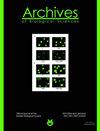Impact of the COVID-19 pandemic on patients receiving intravitreal injections
IF 0.8
4区 生物学
Q4 BIOLOGY
引用次数: 0
Abstract
We analyzed the economic benefits versus safety risks of sharing anti-vascular endothelial growth factor (VEGF) vials during the coronavirus disease (COVID-19) pandemic. This single-center retrospective study analyzed the data of patients with neovascular age-related macular degeneration (nAMD), proliferative diabetic retinopathy (PDR) and retinal vein occlusion (RVO) who received anti- VEGF between January 2016 and July 2021 at Renmin Hospital, Wuhan University, China. Costs were compared of the two protocols of intravitreal injections (IVIs) of ranibizumab, aflibercept and conbercept after (i) splitting the vial content for use in two patients and after (ii) disposal of the remaining vial content after use in a single patient, with the COVID-19 outbreak considered as the demarcation point. The incidence rates of post-injection endophthalmitis (PIE) pre- and post-outbreak were analyzed. The mean cost of a single IVI increased by 33.3%, from 3917.67?71.69 to 5222.67?84.98 Chinese Yuan during the pandemic. The incidences of IVI-related culture-positive PIE were 0.0134% (3 in 22448) and 0.0223% (1 in 4479), respectively, before and after the pandemic (P=0.6532). We conclude that vial sharing of IVIs in a large clinical institution is not associated with increased PIE risk and can significantly reduce the cost of therapy.新冠肺炎疫情对玻璃体内注射患者的影响
我们分析了在冠状病毒病(COVID-19)大流行期间共用抗血管内皮生长因子(VEGF)小瓶的经济效益与安全风险。这项单中心回顾性研究分析了2016年1月至2021年7月在中国武汉大学人民医院接受抗VEGF治疗的新生血管性年龄相关性黄斑变性(nAMD)、增生性糖尿病视网膜病变(PDR)和视网膜静脉闭塞(RVO)患者的数据。以2019冠状病毒病疫情为分界点,比较了雷尼单抗、阿非利塞普和康伯莱玻璃体内注射(IVIs)两种方案在(i)将小瓶内容物分开供两名患者使用和(ii)处理单个患者使用后剩余小瓶内容物后的成本。分析注射后眼内炎(PIE)爆发前后的发生率。大流行期间,单次静脉注射的平均费用从3917.67 - 71.69元增加到5222.67 - 84.98元,增加了33.3%。流感大流行前后与ivi相关的PIE培养阳性发生率分别为0.0134%(3 / 22448)和0.0223% (1 / 4479)(P=0.6532)。我们的结论是,在大型临床机构中,静脉注射共用小瓶与PIE风险增加无关,并且可以显著降低治疗成本。
本文章由计算机程序翻译,如有差异,请以英文原文为准。
求助全文
约1分钟内获得全文
求助全文
来源期刊
CiteScore
1.40
自引率
0.00%
发文量
25
审稿时长
3-8 weeks
期刊介绍:
The Archives of Biological Sciences is a multidisciplinary journal that covers original research in a wide range of subjects in life science, including biology, ecology, human biology and biomedical research.
The Archives of Biological Sciences features articles in genetics, botany and zoology (including higher and lower terrestrial and aquatic plants and animals, prokaryote biology, algology, mycology, entomology, etc.); biological systematics; evolution; biochemistry, molecular and cell biology, including all aspects of normal cell functioning, from embryonic to differentiated tissues and in different pathological states; physiology, including chronobiology, thermal biology, cryobiology; radiobiology; neurobiology; immunology, including human immunology; human biology, including the biological basis of specific human pathologies and disease management.

 求助内容:
求助内容: 应助结果提醒方式:
应助结果提醒方式:


